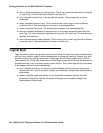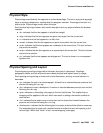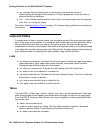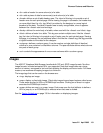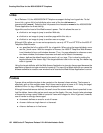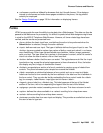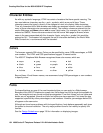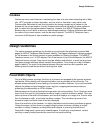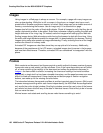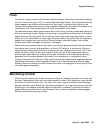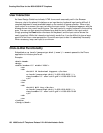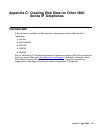
Creating Web Sites for the 4630/4630SW IP Telephone
136 4600 Series IP Telephone Release 2.2 LAN Administrator Guide
Images
Using images in a Web page is always a concern. For example, a page with many images can
slow up downloading. While this is still a concern in the phone, an image’s size has a much
greater effect. Browser and phone memory is limited. Each image can use a sizable amount of
memory, overwhelming the browser. Use an image only if it is essential to a page.
Images also fall into the realm of fixed-width objects. Check all images to verify that they do not
cause a horizontal scrollbar to be added. Scale down a browser image by setting the width and
height attributes of the <img> tag. Or instead, scale the images when setting up the Web site.
Scaling images during Web site setup avoids forcing the browser to deal with the sizing. Using
the width and height attributes scales the image after it is downloaded by the browser. Scaling
images during setup also speeds up image downloading. Finally, reducing the size of the image
reduces the amount of memory used.
Animated GIF images are a bad idea since they use up quite a bit of memory. Additionally,
because of the persistence of the LCD screen, animated images tend to smear in the browser
and lose their effectiveness. Therefore, animated GIFs are considered “not supported” with this
phone.
Frames
While contents and document text frames provide a useful method to browse a series of pages,
frames also use up real estate, just like scrollbars. Even if the frame decorations are all turned
off, a frame containing the majority of the document text suffers the problems discussed in
Images
—the frame width is smaller, increasing the chances of adding a horizontal scrollbar.
Additionally, a single text line has fewer viewable characters, and the page becomes even more
difficult to read and comprehend. Using simple top and bottom page or section navigation
buttons, can make up for the missing contents frame.
The interaction between frames and scrollbars is another important area of concern. While most
browsers manage scrolling within each frame independently, the 4630 Web Access Application
only scrolls the entire (single) window. Scrolling by window moves the user's view of the frames
as a whole, but does not scroll any of the data in individual frames. Data is likely to be in frames
that can never be seen.
Minimal screen real estate and scrolling issues make frames something to avoid.



